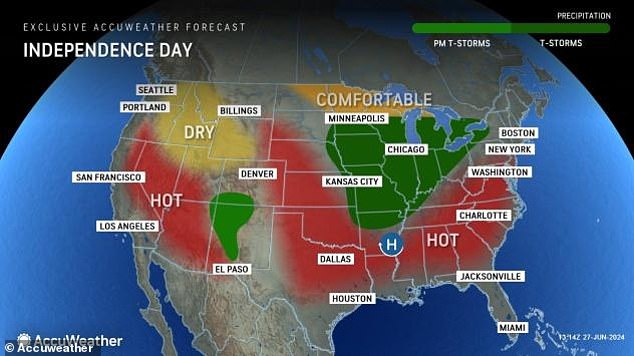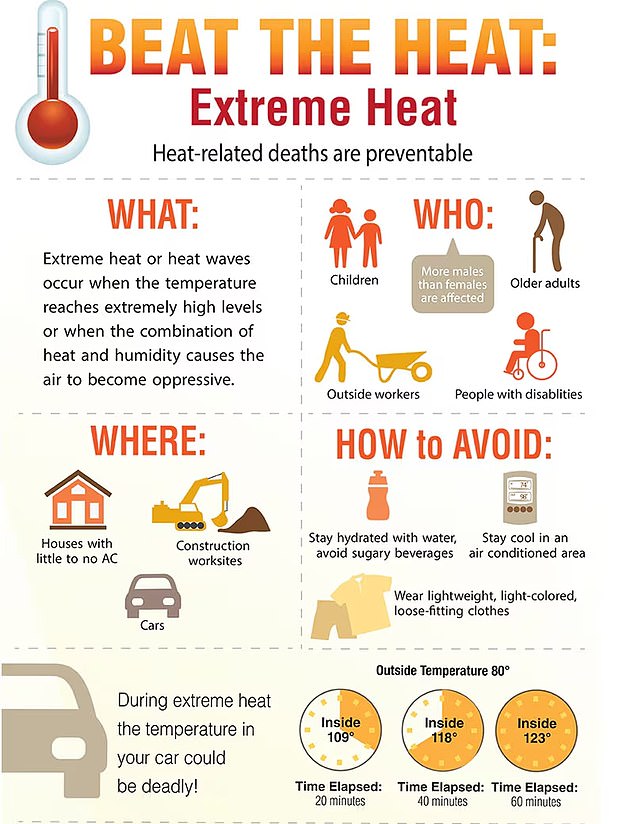Urgent warning for Fourth of July revelers as a scorching heat wave will hit 12 states
An urgent warning has been issued for 12 states as the weather forecast shows that these states will experience a scorching heat wave on July 4.
The National Weather Service advised that many of the southern states will experience sweltering temperatures reaching 90 to 100 degrees Fahrenheit from July 2 through 6.
Heat warnings have already been issued for Texas, Oklahoma and the Carolinas, where the heat index is expected to reach 43 degrees Celsius.
People are advised to stay out of the heat by taking shelter indoors and if they do spend their holiday in the sun, they should drink plenty of water to stay hydrated.
The stifling temperatures will affect tens of millions of people living in the dozen states where there is a 70 to 80 percent chance of above-average temperatures over the Fourth of July weekend.

Nearly 71 million people will travel for Independence Day, making it the busiest ever, but people from Texas to Tennessee will face sweltering temperatures of 90 to 100 degrees Fahrenheit
Stifling temperatures will impact tens of millions of people living in the targeted states, who have a 70 to 80 percent chance of experiencing above-average temperatures next week.
The states in the “hot zone” are Florida, Georgia, Alabama, Mississippi, Louisiana, Texas, Arkansas, Oklahoma, Tennessee, southern Kentucky, North Carolina and South Carolina.
While there is a 50 percent chance of above-average temperatures next week across most of the U.S., including parts of central California, it will be extremely hot, especially in the southern part of the country.
‘Confidence is increasing for a heat wave next week around July 4,’ says the National Weather Service Posted on X.
“If you’re making plans to get outside, big or small, keep an eye on the weather forecast for this weekend.”
The cause is a heat wave that has caused temperatures to rise by more than 32 degrees Celsius since the beginning of June.
A heat dome is formed when warm sea air is trapped in the atmosphere. This is similar to putting a lid on a pot of boiling water.
The hot air expands through the atmosphere, creating a dome-like structure that prevents cooler air from circulating, blocks cloud and rain, and can increase the risk of wildfires.
The extreme heat is expected to last from June to August. Experts fear the heat wave will also cause major droughts in parts of the Midwest, including Illinois, Ohio and Indiana.

While there is a 50 percent chance of above-average temperatures next week across most of the U.S., including parts of central California, the southern part of the country will experience extreme heat

According to the CDC, there are steps you can take to protect yourself from heat-related illness, including drinking plenty of fluids and staying in air-conditioned spaces as much as possible.
“Basically all we get is the sun shining down unobstructed and warming the ground, and there’s no real cloud cover or moisture to keep our temperatures down,” Gabriel A. Vecchi, professor of geosciences at Princeton University, told me. TIME.
Residents of cities such as Dallas (Texas), Charlotte (North Carolina) and New Orleans (Louisiana) should prepare in advance by making sure their homes have adequate water and that they have access to air conditioning.
It only takes 10 to 15 minutes for your body to overheat. If it is not allowed to cool immediately, it can lead to muscle cramps or spasms, dizziness, nausea and vomiting, headaches and death.
Extreme heat kills more people in the US than any other weather pattern, causing the deaths of 1,220 Americans every year, according to US statistics. center for disease control and prevention.
